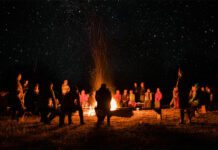Fifteen years ago, Grace and I slowly filled up our couches and dining room chairs until we had enough people to constitute a core group for a church plant. We then held larger meetings for a few dozen people in an epically hot and awful youth room upstairs in a church.
As the church grew, Grace and I kept opening our home more and more nights of the week. In total, perhaps a few thousand people came through our home in a single year. To help with the growing church, elders began also leading small groups in their home. Soon their groups were filled as well. Then, the church exploded as God poured out a ton of grace.
We were in no way prepared to care for all the people God was bringing us. The elders were exhausted with all the counseling and care—they were completely outnumbered. Most of those elders were priests who loved people but not kings who knew how to multiply their ministry by creating systems and training other leaders.
Fast-forward to about eight years ago. The church was running perhaps a few thousand people on Sundays—and had only 15 small groups. At that time, Brad House became an elder. His background was engineering, so he was a king who knew how to architect a system. And he was a priest who loved our people and wanted to ensure we not only cared for them but also mobilized them on mission with Jesus. He began as a volunteer, and over time, built what we now call Community Groups (CG).
Those Community Groups have revolutionized ministry at Mars Hill Church. We now have more than 500 weekly CGs at Mars Hill, with roughly two-thirds of attendees in a weekly group. This is quite remarkable when you also factor in 14 percent of the church was baptized last year as new Christians.
This means we still have tons of new people and lost people to get connected to CGs, but despite fast growth and lots of new Christians, most people are in actual community and on mission, even though we started way behind eight years ago.
Those groups are sermon-based and overseen by elders and led by unpaid church members, and they’re where the majority of service, evangelism, friendship, community, discipline, accountability and the like happen in our church.
Today, we begin each of our Mars Hill Church plants with CGs. Before we get a building, plug in a video projector or sound system, or start a weekly service, we get people together in CGs on mission by the hundreds. Only then do we add a weekly service and the other aspects of what constitutes a biblical church.
To be honest, Pastor Brad has done a wonderful job by the grace of God. So I asked him to please write a book on the subject of community and Community Groups. He was gracious enough to do so, and his book, Community: Take Your Small Group Off Life Support, was released on Sept. 30, 2011 in our Re:Lit line of books. I asked Brad to answer a few questions about the book:
Give us the Community book’s big idea in a few sentences.
The big idea is community is a gift of God that should be life giving and fruitful for the mission of God.
Explain what need the book meets.
This book gives hope to those who have been disappointed in their experience of community and gives them practical steps to reviving community in their church.
How is it different from others in that genre?
Books in this genre usually fall into two camps: philosophical or pragmatic.
The first are often overly idealistic and often champion community over the Gospel. The latter often make little connection to the Gospel but focus more on tricks that seem to work. This book attempts to ground the foundation of community in the Gospel as the most compelling reason for CGs and connects the practical application to this foundation. This brings a consistency to how and why, which few books accomplish in this genre.
How is the content from Community being used at Mars Hill, and what response have you gotten from leaders in other ministries and churches about the content?
The content in the book is the foundation for how we do community at Mars Hill. The response has been great. Leaders feel equipped and empowered to lead and be a part of what God is doing. Outside Mars Hill, the book has been received with excitement as well.
To be honest, the response has been extremely humbling. I have been able to consult with many churches outside Mars Hill and help them move toward a vision for community they have been praying for.
What is the big idea for each chapter of Community?
PART ONE: THE FOUNDATION: BUILDING BLOCKS FOR LIFE
Chapter 1: IMAGE
CGs are a gift of God and a practical outworking of his intention and design for us. Broken by sin, Jesus makes real community possible through the cross. Therefore, Gospel-centered community is more then a place to connect. Rather, it is a tangible proclamation of the reconciling power of the Gospel.
Chapter 2: BODY
CGs should be more than one of many ministries in your church. CGs should be utilized in conjunction with the preaching of the Word to produce transformation through discipleship, pastoral care and mission.
Chapter 3: OWNERSHIP
We must call every member of the church to own the mission of God, not just staff and elders. CG’s offer an accessible opportunity for owning that mission.
PART TWO: HEALTH PLAN: REDEFINING COMMUNITY GROUPS
Chapter 4: COMMUNITY
Traditional small groups can be life-sucking and kill community. Real community is a lifestyle, not an event, and I want to give leaders the freedom to rethink how they experience community in the church. Community is a gift from God and, therefore, should be life-giving.
Chapter 5: NEIGHBORHOOD
We can mobilize the church to mission by utilizing CGs to strategically reach neighborhoods.
Chapter 6: SPACES
Groups need to get out of the living room if they are going to reach non-believers. Spaces provide a framework for them to engage their neighbors.
Chapter 7: RHYTHMS
This chapter helps groups rethink the time, location and content of their group to better align with the natural rhythms of life, thereby making the group more life-giving.
Chapter 8: STRUCTURE
A well-thought-out structure that supports the vision of the church will provide more freedom for groups to be a unique expression of the Gospel.
PART THREE: TREATMENT: EFFECTING CHANGE IN YOUR GROUPS
Chapter 9: REPENTANCE
The big idea is a new system will not change your groups unless you begin with repentance for living safe, unengaged lives to the detriment of God’s call to reach the lost.
Chapter 10: BOOT CAMP
This chapter outlines a seven-week process for taking groups through the material in this book to redirect them toward life-giving groups on mission.
Chapter 11: HISTORY
This chapter traces the history of community at Mars Hill to point out that we haven’t always knocked it out of the park and to give leaders hope that change is possible.
In closing, I want to publicly thank Pastor Brad for years of faithful and fruitful service at Mars Hill along with the willingness to write this book after I asked him. It was a lot of work motivated by love for every church and ministry that loves Jesus and people.
I highly recommend his book. Also, we helped Crossway produce a great video to help promote the book. Check it out.












